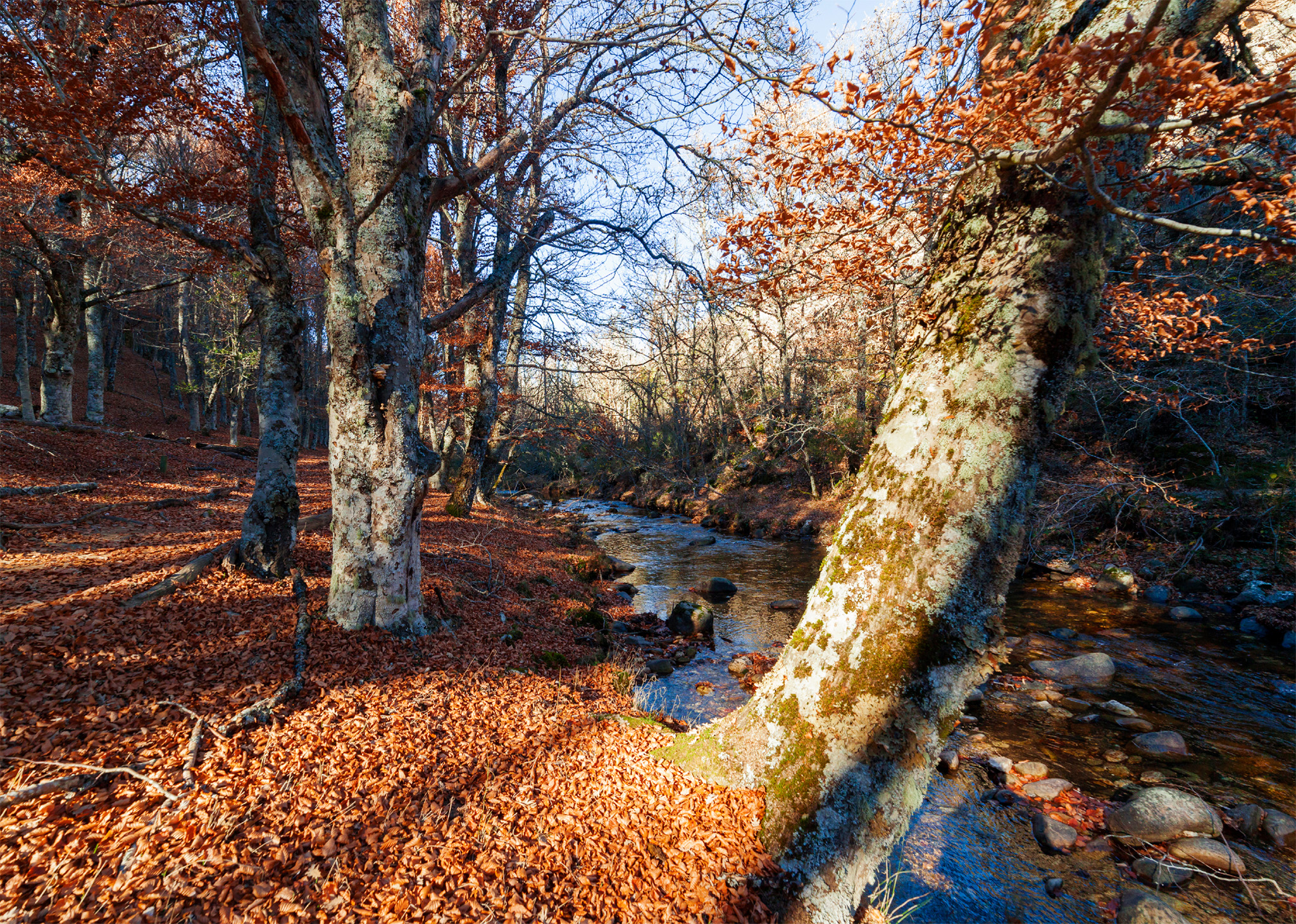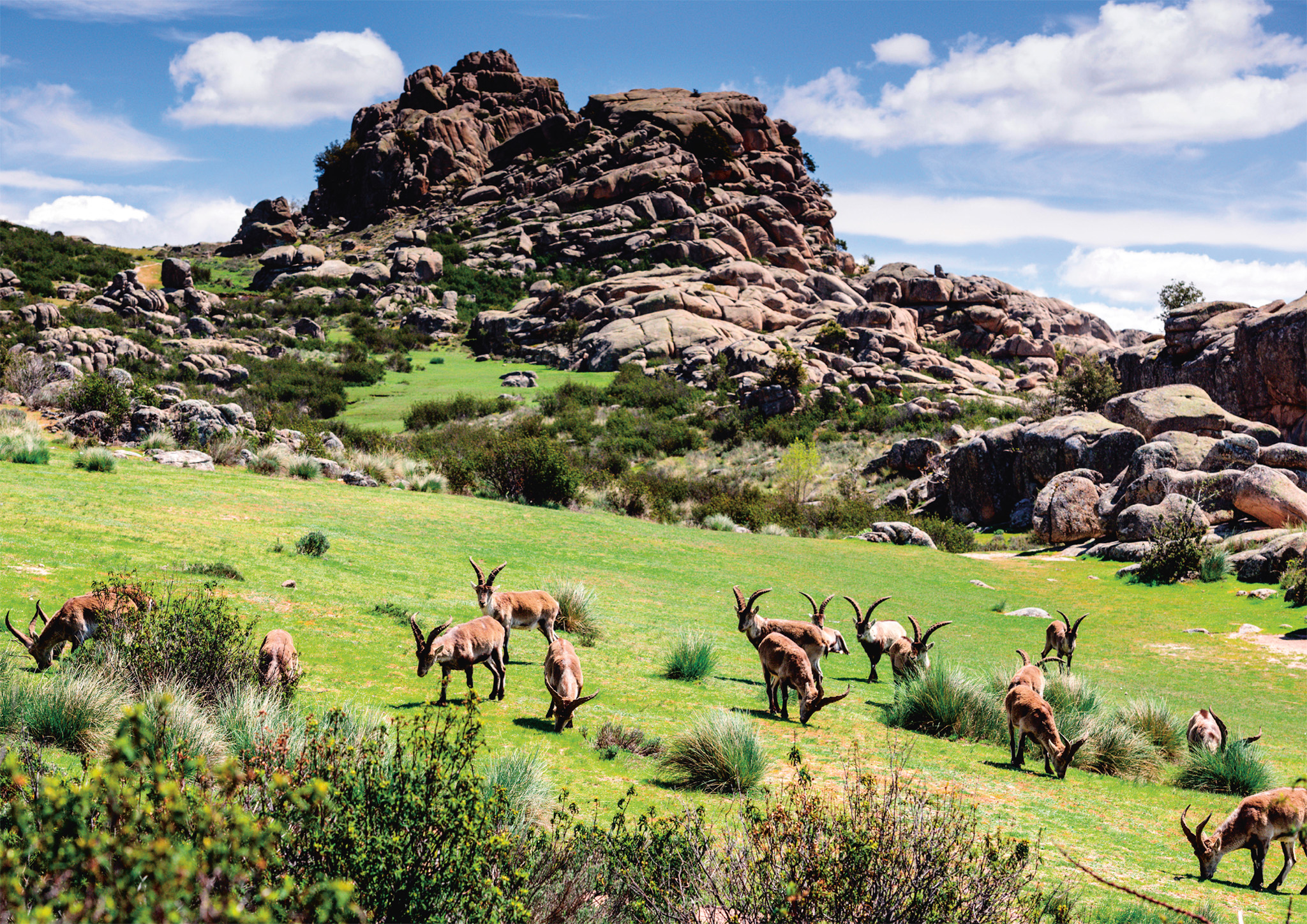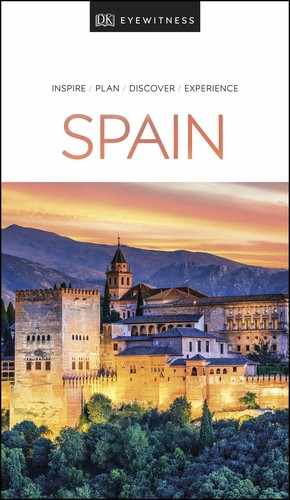Experience More

t Autumn colours displayed in the beech forest at Montejo, Sierra Norte
The black slate hamlets of the Sierra Norte, which were once known as the Sierra Pobre (Poor Sierra), are located in the most attractively rural part of Madrid province.
At Montejo de la Sierra an information centre organizes the rental of traditional houses, horse-riding excursions and visits to the nearby nature reserve of the Hayedo de Montejo de la Sierra. Made a World Heritage Site in 2017, this is one of the most southern beech woods in Europe, and a relic of an era when climatic conditions here were more suitable for the beech.
The drier southern hills slope down to the Embalse de Puentes Viejas, a reservoir where summer chalets cluster around artificial beaches. On the eastern edge of the sierra is the village of Patones, which is thought to have escaped invasion by the Moors and Napoleon’s troops because of its isolated location.
Founded in 1390 as Castile’s first Carthusian monastery, Santa María de El Paular stands on the site of a medieval royal hunting lodge. Although it is mainly Gothic in style, Plateresque and Renaissance features were added later. The monastery was abandoned in 1836, and it fell into disrepair until its restoration in the 1950s. The complex now comprises a working Benedictine monastery, church and private hotel.
The church’s delicate alabaster altarpiece, attributed to Flemish craftsmen, dates from the 15th century. Its panels depict scenes from the life of Jesus. The lavish Baroque camarín (chamber), behind the altar, was designed by Francisco de Hurtado in 1718. The cloister has impressive paintings by Vicente Carducho.
Every Sunday, the monks sing an hour-long Gregorian chant. If they are not busy, they will show you the cloister’s Mudéjar brick vaulting and double sun-clock.
The monastery is a good starting point for exploring the towns of Rascafría and Lozoya. To the southwest is the nature reserve Lagunas de Peñalara.

Great View
Man in the Miradores
Buitrago del Lozoya is surrounded by miradores (viewpoints), but the most jaw-dropping is the Mirador Buitre de Lozoya, on the other side of the Río Lozoya, to the north of town. From here, you'll have an uninterrupted view of the fortified town below.
The granite slopes of the Sierra de Guadarrama are planted with pines and specked by holiday chalets. Villages such as Navacerrada and Cercedilla are popular resorts for skiing, mountain-biking, rock climbing and horse-riding. Keen walkers can follow marked routes from Navacerrada.
The Valle de la Fuenfría, a nature reserve of wild forests, is best reached via Cercedilla. It has a well-preserved stretch of the original Roman road, as well as several picnic spots and marked walking routes.

t The walled town of Buitrago del Lozoya, standing next to the Río Lozoya
Picturesquely sited above a meander in the Río Lozoya is the walled town of Buitrago del Lozoya. The 14th-century Gothic-Mudéjar castle is in ruins, although the gatehouse, arches and stretches of the original Arab wall have survived, and there is an artillery exhibition on the site.
In the newer part of town is the Museo Picasso. The prints, drawings and ceramics were collected by the artist’s friend, Eugenio Arias.
Castle
⌂ Plaza del Castillo s/n # Noon–12:45pm Tue–Fri, noon–1:45pm & 4–5:45pm Sat, noon– 1:45pm Sun
Museo Picasso
⌂ Plaza de Picasso 1 # 11am–1:45pm & 4–6pm Tue–Fri, 10am-2pm & 4–7pm Sat, 10am–2pm Sun & hols ∑ www.madrid.org/museopicasso
EXPERIENCE Comunidad de Madrid
|
Eat Casa José Set in an enchanting mansion, Casa José serves refined dishes such as leek with a broccoli foam and sea anemone. ⌂ Calle de los Abastos 32, Aranjuez ∑ casajose.es ¡¡¡ Montia This Michelin-starred restaurant serves creative dishes made using organic products. ⌂ Calle de Calvario 4, San Lorenzo de El Escorial ∑ montia.es ¡¡¡ El Rumba Expect wonderful charcoal-grilled meats and a sprinkling of modern dishes here. ⌂ Plaza del Dr Gereda 1, Navacerrada ∑ elrumba.com ¡¡¡ |

t Gigantic cross at Valle de los Caídos, a memorial to those who died in the Civil War
General Franco had the Holy Cross of the Valley of the Fallen built as a memorial to those who died in the Civil War. The vast cross is located some 13 km (8 miles) north of El Escorial, and dominates the surrounding countryside. Some Spanish people find it too chilling a symbol of the dictatorship to be enjoyable, while for others its sheer size is rewarding.
The cross is 150 m (490 ft) high and rises above a basilica carved 250 m (820 ft) deep into the rock by prisoners. A number of them died during the 20-year-plus project. Access to the cross itself is currently closed to visitors for safety reasons.
Next to the basilica’s high altar is the plain white tombstone of Franco, and, opposite, that of José Antonio Primo de Rivera, founder of the Falange Española Party. A further 40,000 coffins of soldiers from both sides of the Civil War lie here out of sight, including two unidentified victims.
Among the many magnificent flying machines on display at the museum of Spanish aviation, the star exhibit is the Breguet-XIX Jesús del Gran Poder, which made the first Spanish transatlantic flight in 1929. Others include the 1911 Vilanova-Acedo, one of the first planes made in Spain, and the Henkel 111 German warplane, the only one ever made. Also on display is La Cierva – half-plane, half-helicopter.
Some of the planes are linked with famous people: in 1936 General Franco flew from the Canary Islands to Tetuán to start the Spanish Civil War in the De Havilland Dragon Rapide, while in the Trener Master, Tomás Castaños won the 1964 World Aerobatic Championships.
In addition to aircraft, the museum covers the lives of famous aviators, and features displays of Air Force regalia, flight plans and models. There are also films, videos, photographs and paintings.
Did You Know?
El Cid (1961), starring Charles Heston and Sophia Loren, was shot at Manzanares.
This royal hunting lodge and palace, just outside Madrid’s city limits, lists General Franco among its former residents. A tour takes you round the moated palace’s Habsburg wing and the identical 18th-century extension, designed by Francesco Sabatini. The Bourbon interior is heavy with frescoes, gilt mouldings and tapestries. Today the palace hosts heads of state and royal guests. Surrounding the palace and the 18th-century village of El Pardo is a vast forest of holm oak, popular for picnicking.

t Iberian wild goats grazing on La Pedriza, Manzanares el Real
The skyline of Manzanares el Real is dominated by its restored 15th-century castle. Although the castle has some traditionally military features, such as double machicolations and turrets, it was used mainly as a residence by the Dukes of Infantado. Below the castle is a 16th-century church, a Renaissance portico and fine capitals.
Behind the town, bordering the foothills of the Sierra de Guadarrama, is the geological feature La Pedriza, a mass of granite screes and ravines, which is very popular with climbers. It now forms part of an attractive nature reserve.
The town of Colmenar Viejo, 12 km (7.5 miles) southeast of Manzanares, has a notable church called Basílica de la Asunción de Nuestra Señora.
EXPERIENCE Comunidad de Madrid
|
Stay Condesa de Chinchón A small, great-value hotel with attractive rooms and antique furniture, set around a pretty courtyard. ⌂ Calle de los Huertos 26, Chinchón ∑ condesadechinchon.com ¡¡¡ Hotel Posada Don Jaime This historic hotel has traditionally decorated rooms, a lovely, plant-filled terrace and a plunge pool open in summer months. ⌂ Calle de San Antón 24, San Lorenzo de El Escorial ∑ posadadonjaime.es ¡¡¡ |
The Royal Summer Palace and Gardens of Aranjuez grew up around a medieval hunting lodge standing beside a natural weir, the meeting point of the Tagus and Jarama rivers.
Today’s palace of brick and white stone was built in the 18th century and later redecorated by the Bourbons. A guided tour takes you through numerous Baroque rooms, among them the Chinese Porcelain Room, the Hall of Mirrors and the Smoking Room, modelled on the Alhambra in Granada. It is worth visiting Aranjuez to walk in the 3 sq km (1 sq mile) of shady royal gardens which inspired Joaquín Rodrigo’s Concierto de Aranjuez. The Parterre Garden and the Island Garden survive from the original 16th-century palace.
Between the palace and the Tagus River is the 18th-century Prince’s Garden, decorated with sculptures, fountains and lofty trees from the Americas. In the garden is the Casa de Marinos (Sailors’ House), a museum housing the launches once used by the royal family for trips along the river. At the far end of the garden is the Casa del Labrador (Labourer’s Cottage), a decorative royal pavilion built by Carlos IV.
Aranjuez’s restaurants are famed for their asparagus and strawberries. In summer, a 19th-century steam train, built specifically to carry strawberries, runs between here and the capital.
EXPERIENCE Comunidad de Madrid
Miguel de Cervantes

Miguel de Cervantes Saavedra, Spain’s greatest literary figure, was born in Alcalá de Henares in 1547. After fighting in the naval Battle of Lepanto (1571), he was held captive by the Turks for more than five years. In 1605, when he was almost 60 years old, the first of two parts of his comic masterpiece Don Quixote was published to popular acclaim. He continued writing novels and plays until his death in Madrid on 23 April 1616, the same date that Shakespeare died.

t The Plaza de Cervantes in Alcalá de Henares, bordered by plane trees
At the heart of a modern industrial city is one of Spain’s most renowned university quarters. Founded in 1499 by Cardinal Cisneros, Alcalá’s university became one of the foremost places of learning in 16th-century Europe. The most historic college, San Ildefonso, survives. Former students include Lope de Vega. In 1517 the university produced Europe’s first polyglot Bible, with text in Latin, Greek, Hebrew and Chaldean.
The centre of the city is mostly medieval, with winding cobbled streets and many historic buildings. But rather than these buildings themselves, Alcalá is famed for the many white storks that nest atop them.
Beneath the messy nests you’ll find Alcalá’s cathedral, built between 1497 and 1514, the Museo Casa Natal de Cervantes, birthplace of the Golden Age author, and the restored 19th-century neo-Moorish Palacio de Laredo.
Museo Casa Natal de Cervantes
⌂ Calle Mayor 48 # 10am–6pm Tue–Sun ¢ Some public hols ∑ museocasanataldecervantes.org
Chinchón is arguably Madrid province’s most picturesque town. The 15th- to 16th- century, typically Castilian, porticoed Plaza Mayor has a splendidly theatrical air. Lined with outdoor restaurants and cafés, it is the nerve centre of the town. The square comes alive for the Easter Passion Play, acted out by the townspeople, and during the August bullfights.
The 16th-century church, perched above the square, has an altar painting by Goya, whose brother was a priest here. Just off the square is the 18th-century Augustinian monastery, which has been converted into a parador with a peaceful patio garden. A ruined 15th-century castle is located on a hill to the west of town. Although it is closed to the public, there are fine views of Chinchón and the countryside from outside it.
Chinchón is a popular weekend destination for Madrileños, who come here to sample the excellent chorizo and locally produced anís in the town’s many taverns.
EXPERIENCE Comunidad de Madrid
|
Drink Terraza Los Huertos Named for the kitchen garden of the convent that once stood here, Los Huertos is a sunny spot for an afternoon caña (beer), with a glassed area and tables outside. ⌂ Calle de los Huertos 3, Chinchón § 918 94 00 02 Habana Café On warm summer nights, the place to be seen sipping a cocktail is the terrace of elegantly kitsch Habana Café, a stone’s throw from the royal palace. ⌂ Carretera de Andalucía 11, Aranjuez § 678 50 95 96 |
